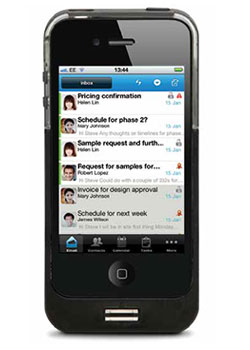
Identity, the New Security Perimeter
Mobile users have access to more information, better communication than ever before
- By Peter Cattaneo
- May 01, 2013
 In the past few years, we have witnessed a dramatic increase in employee mobility.
Whether traveling, working from home, in flex offices or a conference
room at a home office, we expect information access to be immediate and
communication via voice, chat, text or email to be always available. This mobility
started the “Consumerization of IT” that has led to the growing adoption
of the Bring Your Own Device or BYOD trend for mobile phones and tablets.
This has increased productivity as mobile users have access to more information
and better communication using the devices they are most comfortable with. As
users have added business apps to access secure data within the workplace, the
need to link and manage the appropriate identity has led to the emergence of another
growing trend—Bring Your Own Identity or BYOI.
In the past few years, we have witnessed a dramatic increase in employee mobility.
Whether traveling, working from home, in flex offices or a conference
room at a home office, we expect information access to be immediate and
communication via voice, chat, text or email to be always available. This mobility
started the “Consumerization of IT” that has led to the growing adoption
of the Bring Your Own Device or BYOD trend for mobile phones and tablets.
This has increased productivity as mobile users have access to more information
and better communication using the devices they are most comfortable with. As
users have added business apps to access secure data within the workplace, the
need to link and manage the appropriate identity has led to the emergence of another
growing trend—Bring Your Own Identity or BYOI.
One Device, Multiple Identities
On a modern mobile device, the user will have a mixture of personal and work
activities, making it essential to associate each activity with the appropriate digital
identity. An email client and a secure browser for accessing corporate portals are
among the apps that a typical employee will need to complete their job. The corporate
IT department needs to ensure that the digital identity that enables access
to these resources is securely linked to the correct person, as well as be sure they
can disable that access when appropriate. Organizations now realize that users also
need a place on the mobile device for personal apps and data that can function
concurrently with their work activities.
If an enterprise terminates an employee by eliminating access to their mobile
phone, an IT organization must erase all of the work apps and data without touching
the former employee’s personal files.
A New Perimeter
This increased mobility also has contributed to the shift away from perimeterbased
security. If users are no longer behind a firewall, the security perimeter needs
to be redefined. One view is that identity is the new perimeter. The set of applications
used with a work identity and the associated credentials on a mobile device
define a perimeter that an employer needs to manage and secure.
This perimeter needs to be visible to the user. It has to be clear if an employee is
sending a personal or professional email; security is as much about making it easy
for the user to do the correct thing as it is about technical hardening. Since email
may contain enterprise confidential information, apps will be secured with some
kind of lock, a PIN or possibly a biometric check if the phone has the capability.
Fingerprint scanners are already built into or will be featured as an add-on for
some smartphones. Other biometric options, such iris scan or voice recognition,
are being developed.
Once unlocked, the user can interact with data and applications using their
work identity as though they are on a workstation inside the company.
Stronger Authentication, Less Hassle
While the security perimeter is being redefined, it is becoming increasingly apparent
that user name/password are no longer an acceptable level of authentication.
Fortunately, the mobile device presents a robust platform for two, or even three,
factor authentications. Virtually every mobile device has one or more secure elements,
such as the Universal Integrated Circuit Card (UICC), that can be used
to securely store keys and perform cryptographic operations. This can be used to
enhance the security of digital identities. The credentials are stored in the secure
element, and critical elements of cryptography are performed inside it without
exposing the keys.
How to Implement BYOI
Implementing BYOI requires three steps:
- Ensure that the mobile devices are manageable, either by selecting devices with
management capabilities or by using third-party products.
- Implement a mobile identity and credential management solution.
- Select applications that leverage the credentials.
Some mobile devices are designed for remote management. For example,
BlackBerry products were among the earliest adopted in the enterprise due to
their strong IT management features. BYOD created the need for mobile device
management (MDM) solutions that manage all of the phones carried by a corporation’s
employees. MDM products include a server-side management console
and links to the mobile devices. If the mobile devices do not have features, like application
containers, the MDM vendor may include client-side code. While early MDM solutions took over the entire device, providing the features desired by IT
managers, they created conflicts with personal data on the device.
Newer offerings have a variety of ways to connect the MDM console with the
enterprise apps and data, while keeping personal data separate. Mobile application
management (MAM) products also are available to handle the downloading and
updating of apps under enterprise control. Often, this takes the form of a private
app store.
Provisioning and managing identity for BYOI requires a link into the phone
for provisioning and lifecycle management, and at the same time a connection to
the appropriate directory, identity and credential management software in the enterprise.
A number of existing identity and credential management products have
been extended to provide over-the-air (OTA) provisioning and lifecycle management.
A mobile identity solution must implement and manage the specific policies
of the organization.
Many government and commercial organizations in the United States are following
the FIPS-201 standard from the National Institute of Standards and Technology
(NIST) for identity credentials. Initially implemented using smart cards
for public-key infrastructure (PKI) secure badges, the FIPS-201 standard is in the
process of being updated to embrace mobile device support using the concept of
derived credentials. Whether strictly following the NIST standards for full compliance,
or simply using them as a guide for best practice, it is a good idea to use
distinct, derived credentials for each mobile device. One needs to anticipate that
there will be more than one mobile device per user, perhaps a smartphone and a
tablet, and that the devices will be replaced as they are lost, stolen, broken or simply
updated with a newer model.
Finding applications that are credential-aware for secure operations can be a
challenge. Most mobile operating systems do not have standardized interfaces for
cryptographic credentials, so each application has to be selected for the specific
purpose. Several specialists offer products today, and more solutions will be offered
as the pressure to move away from static passwords continues to grow.
Looking to the Future
Modern smartphone and tablet operating systems have support for device, application
and identity management. Looking forward, the industry can see that
the functionality operating systems provide will become richer, offering enhanced
features and better security.
Enhanced security features in the hardware will increase the security of mobile
device use significantly and will add to the isolation between personal and
professional identities. Several handsets already support the ARM Trusted Execution
Environment, which provides hardware protection to prevent malware on the
phone stealing secrets or interfering with the security of apps.
Investments are being made in operating systems to provide higher levels of
support for credential management to support BYOI and to strengthen the security
platform. In 2013, the BlackBerry 10 is adding support for dual personas
with the “Balance” application, and SE Android is the platform for solutions like
the Samsung “Knox” that also offer separate containers for personal and work
applications.
While the focus this year is on managing two identities securely on one device,
as the market matures there will be a trend to support additional identities, each
with its own perimeter. A person might have a second job or want to use a suite
of healthcare apps that link securely to their healthcare provider. In each of these
cases, the device holder will want to enable a set of apps to use a
strongly authenticated identity that is separate from others.
As user mobility continues to increase, devices become more
powerful and BYOD becomes the norm—a critical piece in increasing
productivity and maximizing value.
This article originally appeared in the May 2013 issue of Security Today.